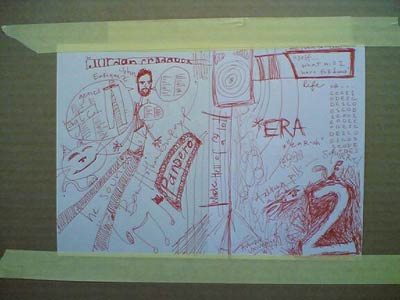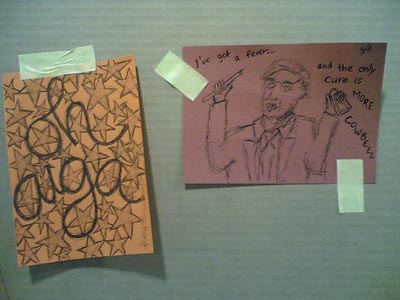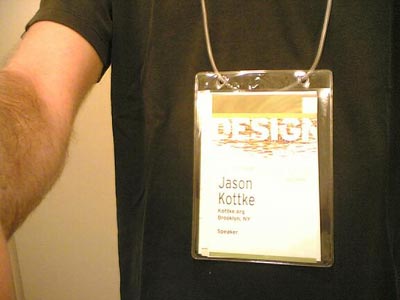kottke.org posts about design
AIGA Voice has an interview with Peter Morville about his new book, Ambient Findability. A question from the interview that everyone responsible for a web site should be asking themselves (emphasis mine): “Can [people] find your content, products and services despite your website?” Love that.
A “song quilt” for Boards of Canada’s The Campfire Headphase album. “Listening to the recording, I ignored song titles; creating images that represent the intangible connection between what I was hearing and what I was ‘seeing’ in my head”. There was a design site that did something like this several years ago…one of the Swanky sites, I think. Ring a bell?
Emigre Magazine has published their last issue (69, dudes!). Rick Poynor, in his farewell post on Design Observer, says goodbye to Emigre. Emigre fueled my interest in design back in the day.
Mirroring the progression of diaries and graphic design, scrapbooking, the practice of arranging and decorating photos in albums, has gone digital. Personal desktop publishing anyone?
Ok, one last wrap-up post about Hong Kong and then we’re focusing on the matter at hand in Bangkok (short summary: having a great time so far here). So, three things I really liked about/in Hong Kong and then some miscellaneous stuff.
1. Octopus cards. I really can’t say enough about how cool these cards are. Wikipedia provides a quickie definition: “The Octopus card is a rechargeable contactless stored value smart card used for electronic payment in online or offline systems in Hong Kong.” It’s a pay-as-you go stored value card…you put $100 bucks on it and “recharge” the card when it’s empty (or when it’s even more than empty…as long as your balance is positive when you use it, you can go into a HK$35 deficit, which you pay when you recharge the card). You can use it on pratically any public transportation in the city: buses, trains, MTR, trams, ferries, etc. It works with vending machines, at 7-Eleven, McDonald’s, Starbucks, and the supermarket. You don’t need to take it out of your wallet or purse to use it, just hold it near the sensor. Your card is not tied to your identity…there’s no PIN, you can pay cash, they don’t need to know your credit card number, SS#, or anything like that. They even make watches and mobile phones that have Octopus built it, so your phone (or watch) becomes your wallet. Mayor Bloomberg, if you’re listening, NYC needs this.
2. The on-train maps for the MTR. Here’s a (sort of blurry) photo (taken with my cameraphone):

The current stop blinks red — in this case, Tsim Sha Tsui (blinking not shown, obviously) — with the subsequent stops lit in red. If the next stop connects to another line, that line blinks as well. A small green arrow indicates which direction you’re traveling and there’s an indictor (not shown) which lights up either “exit this side” or “exit other side” depending which way the doors are going to open. Great design.
3. Muji! We located one in Langham Place (an uber-story mall) in Mong Kok (for reference, the store in Silvercord in TST listed on their site has closed). Muji is kind of hard to describe if you’ve never been to one of their stores before (and if you live in the US, you probably haven’t because they’re aren’t any, aside from a small outpost in the MoMA Store). Adam (see previous link) roughly translates the name as “No Brand, Good Product”, so you can see why I like it so much. They sell a wide variety of products (take a look at their Japanese-only online store for an idea of what they carry); at the Monk Kok store, they had snacks & drinks, some furniture (made out of sturdy cardboard), their signature pens and notebooks (a display of the former was completely surrounded by a moat of teenaged girls, so much so that I didn’t get a chance to test any of the super-thin pens), some clothes (including some great pants that they didn’t have in anything approaching my size), dishes, cosmetics, bath products, and containers of all shapes, sizes, and uses. I wanted one of everything, but settled for a couple of shirts (with absolutely no logos or markings, inside or out, to indictate that they are Muji products).
m1. Big Buddha, worth the trip. It’ll better when the tram from Tung Chung and back is built, although then you’ll miss the boat ride (fun) and the bus ride (harrowing at times).
m2. The Peak Tram. Touristy, but also worth the trip. The weird/ugly anvil-shaped building at the top is currently under construction, so the views will be much better when its finished. Go at night for the best view.
m3. The view from the waterfront in Kowloon of the Hong Kong skyline at night is one of the best in the world.
m4. Speaking of, Hong Kong is a night-time city. All the buildings are lit up, there’s a nightly light show at 8pm (think Laser Floyd without the music), and buildings that appear monolithic in the daytime transform at night, either by disappearing into the darkness while leaving a graceful trace of their outline or acting as huge screens for projected light shows. Reminded me of Vegas in this respect.
m5. We had tea in the lobby of the InterContinental Hotel (go for the view, it’s incredible) and the live band played the theme song from The Lord of the Rings. I tried to get a recording of it with my phone (iPod was back in our hotel room), but it didn’t turn out so well. Very weird; we were cracking up and expecting the theme from Superman or even 3’s Company to follow.
m6. Oh, I’m sure there’s more, so I’ll add it here as I think of stuff.
Story on Muji, the brandless Japanese retailer that has high brand recognition and customer loyalty. (Say wha?) I’ve got a few Muji things and love them.
Slideshow of the biggest emerging design trends according to Murray Moss. This came out of a presentation at the 2005 AIGA Design Conference, which presentation (and audio recording) can be downloaded on the AIGADC resources page.
Harsh review of the user interface for The Complete New Yorker. My experience was better (changing issues took me only a few seconds), but the interface does leave a lot to be desired.
Jakob Nielsen’s latest Alertbox is about weblog usability. I actually think most of these are pretty good, but as with all such guidelines, they are made to be broken.
In the real world, the process of design depends on evolution: “To consider the iPod, it did not spring fully formed from the mind of a powerful Designer, but rather it represents one distinct point on a long evolutionary timeline.” Intelligent design is bad science and bad design. That doesn’t leave much.
Wonderful interview of Milton Glaser by Chip Kidd from a couple of years ago. Touches on his iconic I [heart] NY logo, the updated version (which the NY Commerce Dept. tried to sue him for), and the economics of design. (via df)
The AIGA has podcasts and presentation materials up for some of the speakers from the Design Conference (my full coverage here). Several of the main stage speeches are up, as well as backstage interviews with some of the participants. In particular, I would recommend:
- Audio of the main stage presentation and interview with Juan Enriquez.
- Audio of the main stage presentation by Bill Strickland on The Design of Leadership.
- Audio of the main stage presentation by Milton Glaser and Nicholas Negroponte.
- Audio of the main stage presentation by Murray Moss, although I’m not sure how well this one would work if you listened to it without the slides.
- The PDF of Stefan Sagmeister’s presentation doesn’t make too much sense without the audio, but the last 50 or so slides are worth checking out for the design candy.
These aren’t just for designers; they’re perfectly fine for non-designers as well. Here’s the RSS file with all the resources…it should work well with your favorite podcasting software or newsreader. It’s great that the AIGA is making these presentations freely available…you’re getting a lot of the conference for free here. If I remember correctly, not even O’Reilly offers the presentations or podcasts for download after their events like Etech.
Update: Wrong again! IT Conversations has several podcasts from the last Etech conference. (thx tim)
Profile of Google’s Marissa Mayer, Google’s answer to Apple’s Jonathan Ive. She grew up about 100 miles from me in northern WI.
Paula Scher: “My favorite job is the one I’m going to do tomorrow”.
Here’s a sampling of the rest of the AIGA Design Conference, stuff that I haven’t covered yet and didn’t belong in a post of it’s own:
- Juan Enriquez gave what was probably my favorite talk about what’s going on in the world of genetics right now. I’ve heard him give a variation of this talk before (at PopTech, I think). He started off talking about coding systems and how when they get more efficient (in the way that the Romance languages are more efficient than Chinese languages), the more powerful they become in human hands. Binary is very powerful because you can encode text, images, video, etc. using just two symbols, 1 and 0. Segue to DNA, a four symbol language to make living organisms…obviously quite powerful in human hands.
- Enriquez: All life is imperfectly transmitted code. That’s what evolution is, and without the imperfections, there would be no life. The little differences over long periods of time are what’s important.
- Enriquez again: The mosquito is a flying hypodermic needle. That’s how it delivers malaria to humans. We could use that same capability for vaccinating cows against disease.
- Along with his list of 20 courses he didn’t take in design school, Michael Bierut offered some advice to young designers:
1. Design is the easy part.
2. Learn from your clients, bosses, collaborators, and colleagues.
3. Content is king.
4. Read. Read. Read.
5. Think first, then design.
6. Never forget how lucky you are. Enjoy yourself.
- Nicholas Negroponte: If programmers got paid to remove code from sofware instead of writing new code, software would be a whole lot better.
- Negroponte also shared a story about outfitting the kids in a school in Cambodia with laptops; the kids’ first English word was “Google”, and from what Negroponte said, that was followed closely by “Skype”. He also said the children’s parents loved the laptops because at night, it was the brightest light in the house.
- Christi recorded Milton Glaser’s mother’s spaghetti recipe. “Cook until basically all of the water is evaporated. Mix in bottle of ketchup; HEINZ ketchup.”
- Ben Karlin and Paula Scher on the challenges of making America, The Book: Books are more daunting than doing TV because print allows for a much greater density of jokes. In trying to shoot the cover image, they found that bald eagles cannot be used live for marketing or advertising purposes. The solution? A golden eagle and Photoshop. And for a spread depicting all the Supreme Court Justices in the buff, they struggled — even with the Web — to find nude photos of older people until they found a Vermont nudist colony willing to send them photos because they were big fans of The Daily Show.
- Bill Strickland blew the doors off the conference with his account of the work he’s doing in “curing cancer” — his term for revitalizing violent and crime-ridden neighborhoods — in Pittsburgh. I can’t do justice to his talk, so two short anecdotes. Strickland said he realized that “poor people never have a nice day” so when he built his buildings in these poor black neighbohoods, he put nice fountains out front so that people coming into the building know that they’re entering a space where it’s possible to have a good day. Another time, a bigwig of some sort was visiting the center and asked Strickland about the flowers he saw everywhere. Flowers in the hood? How’d these get here? Strickland told him “you don’t need a task force or study group to buy flowers” and that he’d just got in his car, bought some flowers, brought them back, and set them around the place. His point in all this was creating a place where people feel less dissimilar to each other…black, white, rich, poor, everybody has a right to flowers and an education and to be treated with respect and to have a nice day. You start treating people like that, and surprise!, they thrive. Strickland’s inner city programs have produced Fulbright Scholars, Pulitzer Prize winners, and tons of college graduates.
- I caught 30 minutes of David Peters’ presentation of Typecast: The Art of the Typographic Film Title and realized I should have gotten there in time to see the whole thing. I could sit and watch cool movie titles all day long. Among the titles he showed were Bullit, Panic Room, Dr. Strangelove, Barbarella, The Island of Dr. Moreau, and Superman. The title sequence for Napoleon Dynamite (which was discussed on Design Observer last year) was shown later in the main hall.
- At the closing party at the Museum of Science, we checked out the cool Mathematica exhibit that was designed by Charles and Ray Eames, two designers who were also pretty big science/math nerds.
- And some final thoughts from others at the conference. Peter Merholz says that “form-makers”, which make up the vast majority of the AIGA audience, “are being passed by those who are attempting to use design to serve more strategic ends”. (That’s an interesting thought…) A pair of reviews from Speak Up: Bryony was a bit disappointed with the opening Design Gala but left, like everyone else, in love with emcee John Hockenberry while Armin noted that the preservation of digital files is a big concern for museums in building a collection of graphic design pieces…in 35 years, how are you going load that Quark file or run that Flash movie?
For more of what people are saying about the conference, check out IceRocket. There’s a bunch of photos on Flickr as well.
I quite enjoyed Sagmeister’s presentation on happiness…where else but a design conference would you find a talk on that topic?[1] Early in, he suggested that visualizing happiness with design is easy (photos of someone laughing or a smiley face will do it) but that creating design that provokes happiness in the viewer is something else entirely. He then shared three designs that have made him happy recently:
- Emma Gasson made a day-planner with room for 82 years, the current life expectancy of a British citizen. It looked to be about a foot thick.
- Omnivisu. Richard The and Willy Sengewald constructed a kiosk in Berlin with video cameras inside. When you look into the kiosk through the viewfinder (very much like peering into a pair of binoculars), the cameras record your eyes and beam the video to a nearby location where the images are projected onto a building which rather looks like it’s got a head. When you blink into the kiosk, the building’s head blinks also.
- Ji Lee pastes empty speech bubbles over advertisements on the streets of Manhattan, people often fill them in, and Lee returns to photograph the results.
Sagmeister wrapped up his talk with a list of things he has learned and how he’s used that list in a recent series of projects:
- “everything i do always comes back to me”
- “trying to look good limits my life”
- “everybody thinks they are right”
- “money does not make me happy”
- “thinking life will be better in the future is stupid. i have to live now”
- “complaining is silly. act or forget.”
- “having guts always works out for me”
“Complaining is silly…” is my favorite, both as advice and his implementation of the design. A few of these are in this video shot by Hillman Curtis.
[1] Ok, maybe at a clown conference, but still.
At the beginning of the conference, sketchbooks were distributed to every attendee. We were urged to sketch our thoughts during the sessions & panels in our books and then tape the results onto the Sketch Wall in the Design Fair. As I was too busy typing into my virtual sketchbook (plus, I can’t draw), I left the drawing to others, but I did head down to the Design Fair to see what other attendees had done. Here’s a couple I found interesting:


In addition to the sketches, the wall was also being utilized more generally for graffiti, both written (with marker and paint) and created with the tape used to fasten the sketches to the wall. Here’s a favorite bit of tape graffiti (tapeffiti?):
![I [heart] undo](/cdn-cgi/image/format=auto,fit=scale-down,width=1200,metadata=none//plus/misc/images/aiga-sk-undo.jpg)
That would make a great tshirt.
Coming soon to the MoMa: Safe: Design Takes on Risk “presents more than 300 contemporary products and prototypes designed to protect body and mind from dangerous or stressful circumstances, respond to emergencies, ensure clarity of information, and provide a sense of comfort and security”.
Update: Business Week has a preview of the exhibition as well as a slideshow of some of the objects in the exhibit.
A couple of guys calculated the average color of the universe to be turquiose. Then it turned out they had made an error and the actual color of the universe is beige.
As part of my ongoing series of thoughts about conference badge and program design (Poptech 2004, Web 2.0 2004, PopTech 2003), here’s a quick review of the AIGA conference badges and programs. The badges are pretty good. Both first and last names are printed in large type for easy glancing and the schedule fits in the badge holder.

The badge lanyards are not the usual string/cloth, but a simple length of thin hollow plastic tube that’s looped together with a small piece of plastic that fits inside the tube like so:

If the lanyard is too long (as they often are at these things) and your badge is hanging down to your belt buckle, just grab a scissors, cut a bit off one end of the tube, and stick it back together. The program is a small thick book which I’ve left in my hotel room the entire time, preferring to rely on the Web site for event descriptions and the smaller schedule that fits in the badge holder for times, room numbers, etc. The schedule is actually not a booklet, but a series of folding pieces, one for each day of the conference, so when Friday is over, you can take the Friday schedule out of your badge holder and leave it behind, which is kind of handy.
Newer posts
Older posts








![I [heart] undo](/cdn-cgi/image/format=auto,fit=scale-down,width=1200,metadata=none//plus/misc/images/aiga-sk-undo.jpg)

Stay Connected